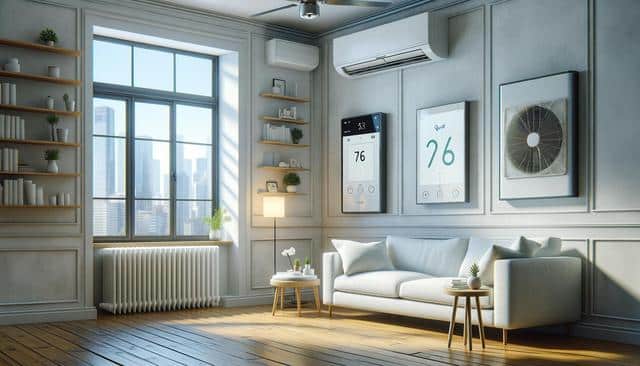
A Guide to Modern Home Cooling Upgrades That Are Quietly Replacing Ceiling Fans
Why Traditional Ceiling Fans Are Losing Popularity
Ceiling fans have long been a go-to solution for home cooling, offering a visible and familiar form of air circulation. However, as home design trends shift toward minimalism and energy efficiency, ceiling fans are increasingly seen as outdated. Their visibility, noise levels, and limited cooling range are prompting homeowners to seek alternatives that are more in tune with modern living spaces.
Several factors contribute to this shift away from ceiling fans:
- Ceiling fans can be noisy, especially older models or those with worn components.
- They provide localized cooling, which may not be effective in larger rooms or open floor plans.
- Modern aesthetics favor cleaner ceilings and concealed systems.
- Energy efficiency standards are encouraging the use of systems that do more with less power.
As technology advances and expectations shift, homeowners are discovering a range of new options that offer better performance, quieter operation, and more design-friendly installations.
Ductless Mini-Split Systems: Quiet and Efficient
One of the most widely adopted alternatives to ceiling fans is the ductless mini-split system. These systems offer powerful cooling capabilities without the need for extensive ductwork or large, noisy units. They are especially well-suited for homeowners looking to upgrade without undergoing a major renovation.
Mini-splits consist of an outdoor compressor and one or more indoor air-handling units. These are typically mounted high on a wall or ceiling, blending into the room’s design. Key benefits include:
- Whisper-quiet operation, ideal for bedrooms and offices
- Energy-efficient cooling with programmable thermostats
- Zoned temperature control for different rooms
- Minimal impact on interior aesthetics
Additionally, mini-split systems often come with heating capabilities, making them a year-round solution. Their flexibility and low profile make them a popular choice for homeowners seeking a modern, unobtrusive cooling option.
Whole-House Ventilation and Heat Recovery Systems
In climates where extreme heat is less frequent, whole-house ventilation systems offer a subtle yet effective alternative to ceiling fans. These systems are designed to improve indoor air quality and maintain comfortable temperatures by continuously exchanging stale indoor air with fresh outdoor air.
Heat recovery ventilators (HRVs) and energy recovery ventilators (ERVs) are two types of systems that are gaining traction. While not traditional cooling systems, they contribute to thermal comfort by reducing indoor humidity and distributing air evenly. Benefits include:
- Improved indoor air quality
- Reduced humidity, which makes the air feel cooler
- Energy savings through heat exchange mechanisms
- Quiet, continuous operation
These systems are especially appealing in energy-efficient homes, where airtight construction can trap heat and moisture. By integrating a ventilation system, homeowners can maintain a comfortable environment without relying on visible cooling devices like fans.
Smart Vents and Zoned Cooling Solutions
Another innovation gaining popularity is the use of smart vents and zoned cooling systems. These solutions allow homeowners to control airflow and temperature in specific rooms, offering a customized comfort experience that ceiling fans can’t match.
Smart vents work by opening and closing automatically based on room occupancy, temperature, or settings in a connected app. When paired with a central HVAC system, they provide:
- Enhanced energy efficiency by cooling only occupied areas
- Reduced need for noisy ceiling fans or portable units
- Integration with smart home ecosystems for automated control
- Discreet design that avoids visual clutter
For those who prefer a more tailored cooling experience, zoned systems are a compelling option. They allow for individual thermostats in different rooms or zones, giving occupants direct control over their environment. This not only improves comfort but can also lead to significant energy savings over time.
Radiant Cooling and Advanced Insulation Techniques
Innovative building materials and cooling technologies are also playing a role in replacing traditional fans. Radiant cooling systems, which involve chilled water circulating through panels or pipes in ceilings or floors, are emerging as a high-performance solution in modern homes. These systems cool a space by absorbing heat energy without moving air, resulting in a completely silent operation.
Radiant systems are particularly effective in well-insulated homes. When combined with advanced insulation techniques and reflective roofing materials, they can maintain comfortable indoor temperatures even during hot weather. Advantages include:
- Silent operation with no moving parts
- Even temperature distribution
- No drafts or air movement, which can disturb occupants
- Compatibility with renewable energy sources
Though more common in new builds or extensive renovations, radiant cooling is gaining attention as homeowners prioritize quiet, efficient, and low-maintenance climate control solutions.
Conclusion: Embracing the Future of Home Cooling
As homeowners seek quieter, more efficient, and aesthetically pleasing alternatives to ceiling fans, the market for modern home cooling solutions continues to expand. From ductless mini-splits to radiant cooling and smart vents, today’s options offer improved performance and greater customization. These systems not only enhance comfort but also align with evolving design preferences and energy goals. Whether you’re upgrading an existing space or planning a new build, exploring these modern cooling technologies can help you create a more comfortable and future-ready home.


